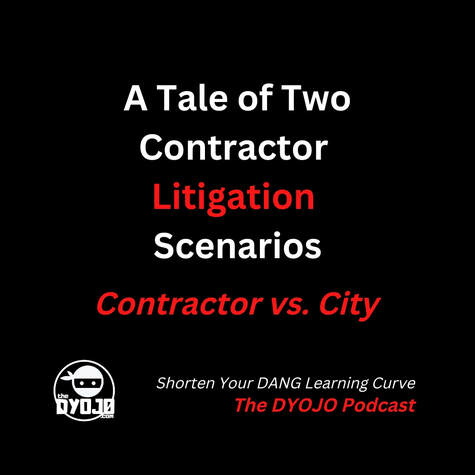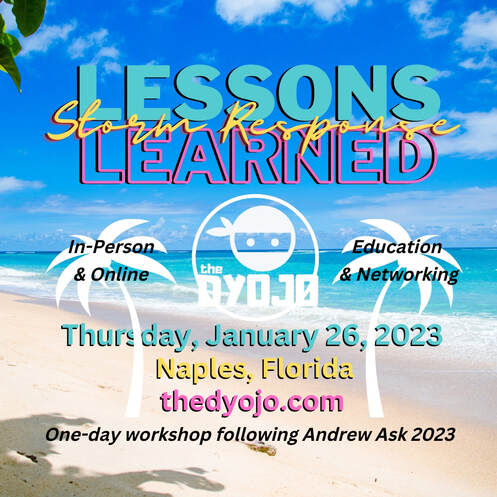|
On Episode 95 of The DYOJO Podcast we discussed A Tale of Two Contractor Litigation Scenarios.
These are two very different litigation experiences. We discuss some of the ways that they are similar and mostly the areas where they diverge. We highlight some of the important lessons contractors can learn from both scenarios. Guest Whitney Wiseman, a contractor out of Palm Springs, Florida joins us to share his insights. He reminds his peers in property restoration, "We are a specialized trade in the construction industry. We all should act like contractors. We should be professional in our state as our state regulates us to. And we should utilize everything that is in our power in order to protect ourselves from a customer screwing us over." Tale #1: RJ Construction v. AI School DistrictOn prior episodes of The DYOJO podcast we've been talking about a case out of Texas. One of the local news broadcasts summarizes this litigation tale in this manner, "An Arlington construction company says it worked around the clock last February [2021] to clean up a flooded school. Months later it says it has yet to be paid." This is in reference to Robert Jordan Construction (RJC) versus the Arlington Independent School District (AISD). In this case, Robert Jordan Construction responded to flooding after Winter Storm Uri hit the area in 2021. RJC thought they had an agreement about the scope and the cost, but they discovered (or ignored) that was not the case. We've been unlocking as many of the pieces to that story as we've been able to find in the court documents and public records. So it's brought to light some questions, some teachable moments for contractors, especially for those who are new or newer to larger projects. On an insurance claim project like this one, there are multiple parties are involved. It's not just the customer, the insurance company, and the contractor. Whitney Wiseman reminds contractors, "What we're talking about today, which I think is so important," is for all contractors to, "Do your job. Do your documentation. Be transparent. Be a stand up contractor. If you do those things, you shouldn't end up in a situation like homeboy did out in Texas." Tale #2: Conway Construction v. City of PuyallupTale number two is a case that came across the desk here at The DYOJO Podcast. It's called Conway Construction versus the city of Puyallup. Some of you may recognize that is the town that I currently reside in. It's just outside of Tacoma, which is just South of Seattle in Washington State. Are you aware that when a contract is terminated, there's two terms under which it can be terminated:
These distinctions are something that all contractors should be aware of and ensure they are addressed in their contracts. There needs to be specific language that outlines what happens if the customer finds a defect or is unhappy with the performance of the contractor. Language should include a description of the notification process as well as how the contractor will respond. Usually the customer is responsible to notify the contractor of a defect in writing. The contractor will have X number of days to come up with a remedial plan that is agreeable to all parties. If the issue isn't resolved with the corrective actions, or if the parties can't come to agreement, then the contract explains how the process will proceed. One of the most important things any contractor and customer can do to avoid litigation is to agree on a process for how disagreements will be resolved. In the event that the worst happens, how will both parties terminate the agreement with the least amount of collateral damage? If the customer is going to terminate the contract for cause, there is a process. Every contractor should have a conversation with their client explaining that if they believe there's something wrong with the project, the contractor has first rights to try to remedy the issue. A quality contractor wants to make things right. If this process is outlined in the contractual agreement but the customer doesn't follow that, as the City of Puyallup didn't follow their own contract, then they may surrender their default claim. Most contracts can be terminated at will, or for convenience, as long as no bad will is in play. So a customer doesn't need a reason to kick a contractor off of a job but they will need to follow the termination for convenience process outlined in the contract. Especially, as was in the case of Conway v. Puyallup, if the customer was the one that drafted the contract terms. This case reminds contractors and customers to be aware another item which is "the plain and ordinary meaning" of the words utilized in the contract. The Supreme Court of Washington emphasized when the contract terms are clear, the court will enforce it as written. As a contractor, it is important that a non-legal person can read and understand the contract. Two Types of Contract TerminationWithin the contract between Conway Construction and the City of Puyallup, it stated that a termination for convenience would entitle the contractor to greater damages than if it was terminated for cause. Under the agreement, a contractor terminated for convenience was entitled to be paid for all actual work performed until the date of termination. While the city terminated the contract claiming it was because of the contractors alleged breach of the agreement. When the trial judge reviewed the facts they ruled that the termination was not for cause. Since the termination was not for cause, the contract terms converted the termination of Conway Construction to one for convenience. The Supreme Court of Washington ultimately affirmed that decision. The high court reached this conclusion simply by reviewing the plain language of the contract. The termination for cause could only be based on defective work if the contractor neglected or refused to correct rejected work. This mutual agreement further provided that upon 15 days written notice the contractor had to remedy the work to the satisfaction of the city. If the reader has been following our review of RJC vs. AISD, they will note that the facts of this Conway case vary significantly from those outlined in the Robert Jordan court documents.
A contractor should document everything from the agreements that they make, the conversations that they have with any party to the project, and any essential communication related to defects, defaults, and remedies. A typical communication (or Comms) log, such as those we have recommended before on the podcast, might include:
The contractor in this case was able to document that it took steps to remedy the alleged defaults and reached out to the city to determine if the corrective efforts were sufficient. The city however, refused to meet with the contractor. The trial judge therefore found that the contractor was not neglecting or refusing to correct the defect and that the city's failure and refusal to meet with the contractor to discuss the remedial actions was unreasonable or made in bad faith which had the effect of making the termination one for convenience rather than one for cause. The court stated their decision was thereby bound by the terms of the contract. Customizing Construction ContractsRegular listeners will remember Bebo Crain form our prior discussions regarding RJC v. AISD. Bebo believes, "You gotta adapt your situation. Each project has different amounts of risk and the protections [in your contract] depend on the amount of risk. I recommend getting a lawyer that will sit down with you to write a contract for your situtaion. You write out the things that you have done wrong and identify those as your risks. As more risks come you will work with your attorney to add those to your contract. It can be an evolving contract. As you obtain more situations that you feel you might be entering risk and learn how to hedge that risk with your contract and your disclosures." These two litigation scenarios remind contractors of a couple of key elements:
A contract is agreed to by both parties. In the RJC case one of the arguments is whether there ever was an agreement in place. In the Conway case, the contractor signed off on the process of default and made a good faith effort towards addressing the issues that the customer brought to their attention. In the RJC case we shared a news clip that says the school district is asking for documentation that the contract says doesn't exist. In the Conway case the contractor documented their process all the way through the project. Their documentation was sufficient enough that it held up in court. Conway was able to show they were within the terms of the agreement. According to court proceedings in the Conway case, the customer came to the contractor with the defect issue(s). Upon 15 days written notice the contractor had to remedy the work to the satisfaction of the city. The notice from the customer was to be in writing. It is usually in everyone's best interest to attempt to settle a disagreement prior to going to court. In Conway, the contractor received notice, made the corrections, and documented their follow through. It is important to be able to present documentation of agreements, phone calls, emails, text messages, meetings, and any other form of communication with the client. The contractor showed:
The contractor can say, we understand the language of the contract, we did the right thing, because we followed through with the remedial action, and we documented our processes. The court read the agreement, saw the facts, and concluded that this termination was no longer for cause. In this case the language of this contract was dictated by the city. This is often the case for government work, where the government entity presents the bidding terms as well as the terms of the agreement. The contractor should therefore carefully read their agreements, especially when the agreement is drafted by the other party, and understand all of its terms before signing. Then if the dispute arises, the contractor can use the plain language of the contract to argue in support of its position in the dispute. Learning From Contractor PodcastsFrom the feedback we have received on our podcast, contractors enjoy hearing other contractor's stories. It can be helpful to hear from someone else who has been there and done that. It is good for contractors to shorten their learning curve but they should understand that they cannot outsource or replace their learning curve. Gaining experience and adapting your operating procedures are critical to building a sustainable business. Whitney Wiseman encourages restoration contractors to, "Reach outside of social media. Find individuals who excel in their space. Make sure that you learn as much as you possibly can from these individuals who are not trying to make money off of you and truly want to be your mentors." Mr. Wiseman paused during our discussion because he sees an issue. He says, "I see more mentors in our industry right now that want to make money off of everybody who's green, then I do individuals who are just willing to help. And to me, that's sad, because I came up in this industry where there were people who would answer their phone, give me the advice that I need, and it was free. But right now it's a weird world." While Whitney advises that contractors are cautious with whom they trust, he also says, "There's a lot of people, though, that can really help you to be the best in the industry. Reach inside the industry for those people. But, when it comes to contracts, when it comes to business, when it comes to all these other things, get as far outside of this industry's mindset as you can and started attacking it as a professional. For instance, we [property restoration contractors and claims professionals] are a specialized trade in the construction industry. We all should act like contractors. We should be professional in our state as our state regulates us too. We should utilize everything that is in our power in order to protect ourselves from a customer screwing us over. At no point in time should we use these shortcuts in order to gain success because I can guarantee every single person the long road is worth it every single time versus the shortcuts. Learn from my mistakes." Lesson Learned from Storm Response WorkshopIf you would like to be in person with people that are experts in the industry that have years and years of experience, and are sharing their stories, join us Thursday, January 26, 2023. The DYOJO is traveling to Naples, Florida, for the Andrew Ask Building Science Symposium (aka Winter Break 2023). Andrew Ask runs Tuesday and Wednesday, then separate from that but at the same location, Pete Consigli and Jon Isaacson will be putting together a one day workshop titled Lessons Learned from Storm Response and Hurricane Recovery. Be there or be square.
0 Comments
Leave a Reply. |
Words
The DYOJO - helping contractors shorten Archives
June 2024
Categories
All
EstimatingMarketingInsurance ClaimsLeadership |
|
| |||||||




 RSS Feed
RSS Feed
